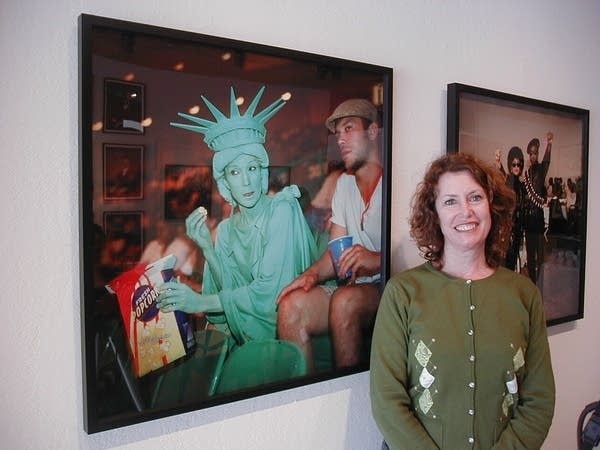Is it right to call a Lincoln impersonator "Honest Abe"?
Go Deeper.
Create an account or log in to save stories.
Like this?
Thanks for liking this story! We have added it to a list of your favorite stories.

On a recent Friday night, Gallery 13 in Minneapolis was filled to the brim for the opening night of its new show, "Using History." A jug band plays to entertain the crowd, but the audience's eyes are drawn to the photographs by Greta Pratt hanging on the wall.
Moorhead State University art student Valerie Michaelson drove down to Minneapolis for the weekend to check out the gallery scene, and she's thrilled to have stumbled across this exhibit.

An entire wall of the gallery is hung with portraits of Abraham Lincoln impersonators. In one, Lincoln stands next to his RV, which he's outfitted to look like a log cabin. Michaelson thinks it's hilarious, but thought-provoking, too.
"The fact that we can recognize the symbol so readily," says Michaelson. "It doesn't matter who's playing the part. We have that connection with Abe through our money, through the penny... it's a symbol of integrity and yet it's fooling us. It's a juxtaposition between integrity and a joke."
Turn Up Your Support
MPR News helps you turn down the noise and build shared understanding. Turn up your support for this public resource and keep trusted journalism accessible to all.
Michaelson says the exhibit presents a fresh take on historical symbols, juxtaposing their idealism with modern-day commercialism.
A Caucasian family dressed up as American Indians for a local fair is caught afterwards, loading up their grocery cart with Wonder Bread.
A woman dressed convincingly as the Statue of Liberty munches on popcorn while sitting in the bleachers at a baseball game.

Photographer Greta Pratt says she was inspired to create this series of photographs by an image she saw just after the World Trade Center attacks of Sept. 11, 2001. It was a poster of Osama Bin Laden, which said, "Wanted: Dead or Alive."
"I started to realize how that poster could be in a Wild West town, and how those symbols of history -- of which so much of it is mythology -- works to affect Americans today," says Pratt. "Symbols rooted in history create a national identity that binds us together and affects the direction that the country goes in."
Even before 9/11, Pratt had been scouring the United States, looking for fairs and festivals where people relive the past, or reinvent it. She found people dressing up as Black Panthers, Wild West outlaws, and Confederate soldiers.
"I think reliving the history of forefathers is fine, depending on what history you choose to relive," says historian Howard Zinn, the author of "A People's History of the United States."

Zinn finds Pratt's photographs provocative. Zinn says he hopes viewers will contemplate why Americans so enjoy re-enacting battles. Zinn says he worries about the consequences of glorifying our military past.
"I think the real danger is the creation of a passive citizenry, that simply accepts uncritically everything that has happened in the past," says Zinn, "that doesn't really look with a very honest eye at the things that have happened in our country which we are not proud of."
Zinn wonders why re-enactors never choose to present the massacre of Indians at Wounded Knee. But to be fair, historical re-enactments are not a convenient arena to debate complex historical issues.
Re-enactors like Eric Ferguson say they're simply trying to offer a snapshot of history. Ferguson used to work at Fort Snelling. He now participates in two volunteer re-enactment groups. One portrays the oft-forgotten War of 1812.

Ferguson says they're attempting to create a point of entry for people from which to explore the story further.
"Some people learn from documentaries, some people do best in a classroom, some people prefer history books. I wouldn't want to replace any of that because I've used all of those myself," says Ferguson. "It's simply another way of doing it. For some people, the book doesn't make sense; you have to put something in their hand."
Ferguson says in his re-enactments of the War of 1812, he plays on the side of the British, who lost. For him, it's a way to see history from the other point of view -- just as the Caucasians in Pratt's photographs are doing when they dress up as Indians.
University of Minnesota art history professor Karal Ann Marling says "playing dress up" is one way in which American society seeks to recreate itself.
"There's something in a way both creepy and delightful about seeing little kids running around dressed as Dakotas or Ojibwes, and the innocence with which they do it," says Marling. "They're not bent on killing a single soul, they're not recreating the great Sioux-U.S. war; they're living imaginatively in the forest. In other words, they've rewritten history through enacting it, and I find that ultimately something to celebrate. "
Celebrate, but also question. Greta Pratt says she hopes her photographs inspire Americans to think about our history and to ask ourselves if the symbols we seem to have chosen really represent our common identity.
The exhibition "Using History" continues at Gallery 13 in Minneapolis through April 23.







